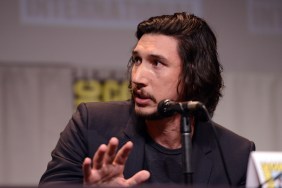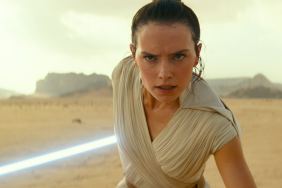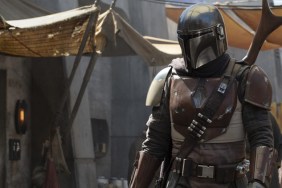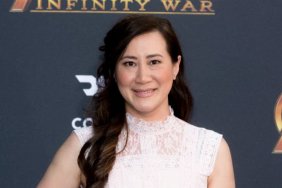Roger Guyett has worked in computer graphics since the mid-1990s and has been nominated for numerous Oscars for his work on various Star Trek, Star Wars, and Harry Potter films. Patrick Tubach is a digital artist who has worked on just about every superhero flick you’ve loved in the last ten years. Both have previously worked on the Star Wars prequels, and now they are presenting some of their best work yet in Star Wars: The Force Awakens, a film seen by everyone and their mothers. (As of this writing, it has made 950 quintillion dollars in Kansas alone.)
Also: Oscars 2016 | Neal Scanlan & Chris Corbould on the Creatures of ‘Star Wars: The Force Awakens’
Guyett and Tubach recently had a conversation with Crave about the unique demands of working on the new Star Wars film, the work ethos of the project, and how working on a new Star Wars film contrasts with working on an older one. And, as all conversations about Star Wars must, we began with details about the punk-metal band The Plasmatics (I was wearing a Plasmatics shirt at the interview).
CraveOnline: Wendy O. Williams, the lead singer, famously stood on top of a moving school bus in her video for “The Damned,” and then drove it through a wall of television sets. That’s all you need to know about The Plasmatics. You don’t need to know anything about the music.
Patrick Tubach: Red Fang did a video that was very similar to that. They took the money that they record label gave them; they bought a bunch of stuff, and they drove their station wagon through it. I bet it was inspired by that.
I bet. Williams used to chainsaw cars in half on stage. She was awesome.
Roger Guyett: Did you get to see them live?
I was too young to see Plasmatics shows. I’ve only seen the videos. But to that Star Wars movie…
PT: Yeah, that little independent movie.
The original Star Wars movies were practical, and the newer ones were largely digital. As the effects technicians on this new one, what was the general decree?
RG: I think the general approach was just to shoot as much in-camera as we could. And I think if you look at those movies, it feels like you’re going to a place and filming in that place. Build sets. It’s very old-fashioned filmmaking isn’t it? They didn’t rely so heavily on visual effects. So you actually go to a desert. You’re in a desert. You meet some droids. So it goes on. So we kind of wanted to recapture the spirit of that. But, at the same time, you don’t want to ignore the technology that’s available to you. And somehow ride that line. And, obviously, a movie like Star Wars doesn’t exist without the special effects. So how do you go about solving that?
Sort of our approach was this: On one extreme, you have all of in-camera stuff, and the charms and simplicity of some of the creatures that are there, in-camera, in front of you. Then we jump to the other extreme, and went just super high-technology. Of all the things that are available to us now, at this moment in time, we said “Well now we can do an incredible version of the Millennium Falcon. And render it. And, hopefully, people will believe it’s there.
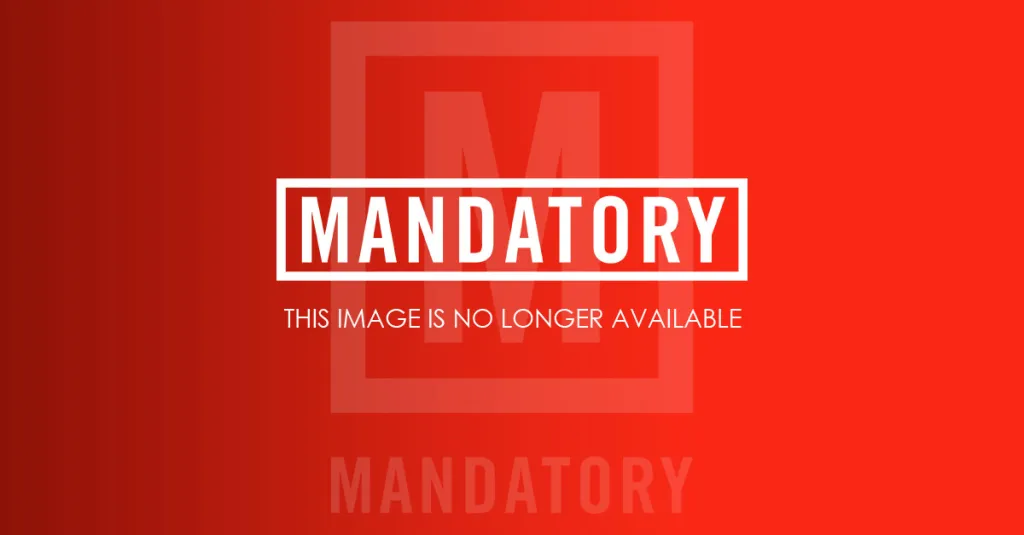
Disney
And, you know, even if you had used another kind of technology – you could have used miniatures or something like that – I don’t think you could have achieved that level of realism by using a miniature. Because of the interactivity with everything else. You still have to do all of the dust. If you remember, the Falcon takes off, then hits the ground, then starts moving around, and there are explosions going on around it. You want to sort of have the thing be a complete event. If that was really happening, that would all be happening in front of you. The Millennium Falcon would be taking off, and the TIE Fighter would be swooping in, and the dust from that would block your view of the ship! So we were trying to, for realism, trying to imagine that thing playing out. And I thought we had more of a chance doing that digitally than we would have by other means.
PT: The guys who worked on the original films were real innovators, and real pioneers of their time. And talking to someone like Scott Ferrer who shot a lot of the miniatures of the ships for Return of the Jedi. We would look at shots of ships together, and the memories would come flooding back to him, and he would say “Well that’s not really what I wanted the camera to do. I had to do that because I could get X to happen or Y to happen.” And so, what you learn from talking to them is that they did what they could do with the technology available to them at the time. And now that Scott has gone on to work on Transformers films and everything else. Now that we have these new technologies available to us, there’s no reason we shouldn’t take advantage of them to produce better shots.
And that’s what we’re trying to do. As long as you can nail the realism of the ships, with the technology we have today, you can do so much more with the animation. We’re not saying that we don’t love those old shots. We do. But what we can do now is get the shot we really want. What [director] J.J. [Abrams] really wants for the film. And it’s something that’s really freeing, to be able to say “Okay, I’m not going to have to limit myself to the constraints of whatever I can build. I can go out and do whatever I need to do.”
RG: A lot of those practical approaches are all based around the physicality of doing something. We actually built a part of a Millennium Falcon for the movie. Because it meant we could do some in-camera work. But the thing is, once you put it somewhere, it’s a hell of a thing to move. It’s a set. One of the fun things we’re involved in is this enormous jigsaw puzzle of just what is the best way to do something. For that moment in the movie – and this is sort of an ongoing and very complicated jigsaw puzzle – for that sequence. I honestly thought we’d shoot more miniatures than we did. But the technology is so rapidly developing – and we even developed some new tools for the show – that it really kind of closed that gap.

Disney
But, the one thing we really paid attention to was trying to make it feel like we were really shooting that event as opposed to, you know, that “I can put the camera wherever I want” attitude. With that, you’re suddenly in this other thing. We were more like “Well, if that thing was really taking off…” It was part of our restraint. Our own kind of self-checking mechanism. “I’m in an X-Wing now.” Kind of like “I’m in an F-16 now.” And where would I put the camera? Well, I could lock it on the side! You could probably strap that thing on the side.
So if you watch the movie, you saw a lot of air-to-air type shots. But we were also doing more subjective-y things. People’s POVs through cockpit windows. But it’s all based on a film language that we’re all familiar with. Knowing you could do that.
After having worked on the Star Wars prequels – films which really did employ the “I can put the camera anywhere” aesthetic – was this approach freeing? Jarring? Merely different?
RG: I think you’re working with different directors, and it’s a different time. And, well, both of us worked on the prequel movies, and honestly I am very proud of what we did at the time. But that was at a time when digital technology had shown it could achieve a certain degree of impressive work. And at that point there was an explosion in the field. Those prequel movies are almost like fully animated movies with a few people in them. So little was built for those movies, and we were creating the environments. And, in a way – regardless of whether or not you liked the movie or like the look of the movie – what that was was a really interesting statement. “I want to try something completely different.”
It’s a credit to [George Lucas] that he thought to say “I bet you could make a whole movie this way. Where we can make up everything. And I can put the camera anywhere.”
PT: Use your imagination to its fullest extent.
RG: And that’s very interesting and very brave. As it turns out, it may not have been what Star Wars fans wanted.

Disney
This is a naïve question, but explain to me how you contribute to the film. How much do you get to invent creatively? Do you storyboard sequences, or are you assigned storyboards?
RG: Most of the sequences with J.J., he already has in mind. He has a sequence that he feels comfortable with. Quite often, he can be extremely specific about a sequence of events that he expects to be happening in that sequence. He’ll say things like “Now I want a really wide shot where you can see the whole sequence.” What we’re able to do is we can take that – and he’s not overly detailed sometimes; he can say “give me a version of that sequence” – and we’ll go away and we start constructing that. And what we’re doing at that point is what we call a “post-viz.” Where we’re basically putting together an entire animatic ourselves based on the description – however vague – of events.
A shot of a guy in a cockpit on bluescreen shouting “Look out behind you!” You cut to a wide shot of an X-Wing coming through the frame and a TIE Fighter firing. Cut to the pilot going “Look out,” and now you’re in a moment where you can actually start watching the sequence.
We might show that to him, and he’ll go “Oh! Well maybe there’s a version of this where you reverse those two shots around, we can include the wider shot and include the Starkiller base in the background.” Because we’re seeing it, but he’s not, we might do two variations of that sequence, and show him both, and let him decide. It’s like he said “I want chicken for dinner,” and we said “Well, we’ve got chicken, but the beef tenderloin special is great.” And he’ll take a look and say “I see why you did that. Maybe we can combine those ideas.” But sometimes he’s very specific. He wants chicken.
PT: We give him the visual tools he needs to construct a scene. And then he comes back at you with a new idea. And then you do another version of that.
What got cut?
PT: It’s hard to remember because there were so many sequences in this movie. There were moments in every scene that didn’t make it through to the end. There are moments when you come across something that’s not story-driven. And you think that those are kind of cool. But ultimately it doesn’t fit.
RG: But that’s just filmmaking.
Top image: Disney
Witney Seibold is a contributor to the CraveOnline Film Channel, and co-host of The B-Movies Podcast. You can follow him on “Twitter” at @WitneySeibold, where he is slowly losing his mind.
The 25 Most Badass Best Picture Nominees:
25 Badass Best Picture Nominees
-
Captain Blood
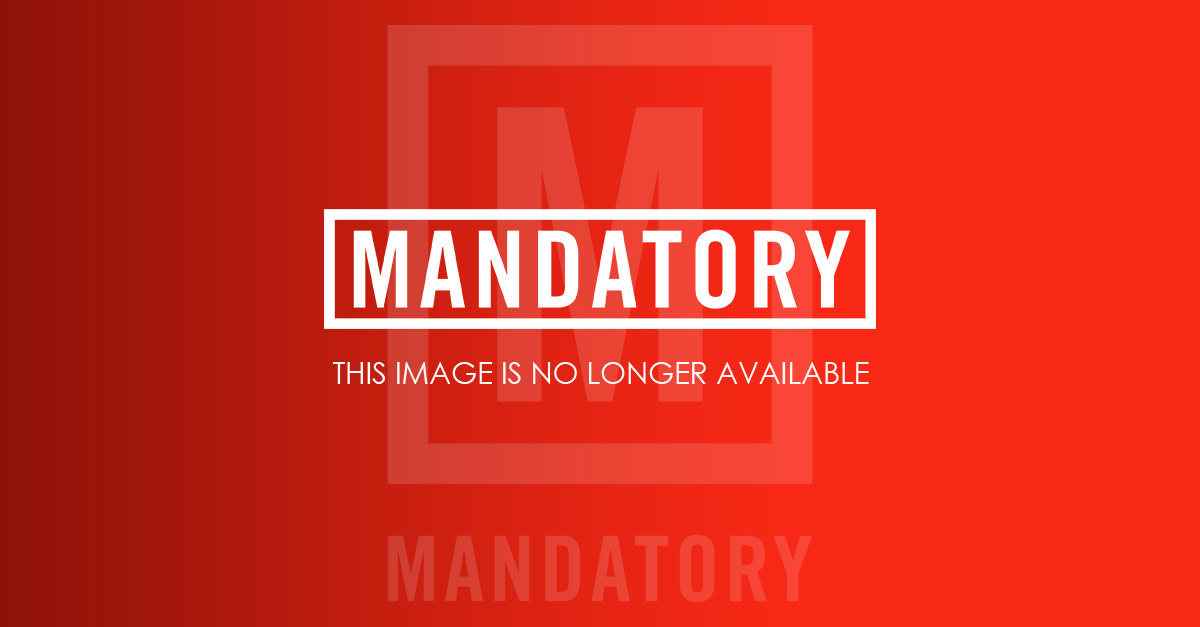
Lost To: Mutiny on the Bounty
Action star Err0l Flynn headlines this rollicking swashbuckler about a doctor who goes rogue and becomes a pirate.
Photo: Warner Bros.
-
The Adventures of Robin Hood

Lost To: You Can't Take It With You
Errol Flynn re-teamed with his Captain Blood director Michael Curtiz for this iconic adventure that defined the folk hero Robin Hood for decades.
Photo: Warner Bros.
-
King Solomon's Mines

Lost To: All About Eve
H. Rider Haggard's classic novel became an acclaimed adventure starring the great Stewart Granger as Allan Quatermain, who has to escort Deborah Kerr into the heart of Africa to find her lost husband and an ancient treasure.
Photo: MGM
-
The Guns of Navarone

Lost To: West Side Story
One of the great "men on a mission" movies stars Gregory Peck, Anthony Quinn and David Niven as soldiers who embark on an impossible mission to take out powerful Nazi weapons that were threatening the Allied Navy.
Photo: Columbia Pictures
-
A Clockwork Orange

Lost To: The French Connection
Vicious, twisted and violent, Stanley Kubrick's adaptation of Anthony Burgess's novel - about a teenaged criminal who undergoes psychological conditioning to "cure" his antisocial urges - is one of the few X-rated films to ever be nominated for Best Picture.
Photo: Warner Bros.
-
Deliverance

Lost To: The Godfather
John Boorman's thriller sends Burt Reynolds, Ned Beatty and Ronny Cox into the wilderness and challenges their masculinity at every turn. The "squeal like a pig" sequence is just as disturbing as ever.
Photo: Warner Bros.
-
The Exorcist

Lost To: The Sting
William Friedkin's impressive adaptation of William Peter Blatty's novel - about a child with a mysterious ailment that may be supernatural in origin, challenging contemporary secular beliefs - is still one of the biggest blockbusters of all time. The Exorcist is so scary that some people believed the actual celluloid was haunted.
Photo: Warner Bros.
-
The Towering Inferno

Lost To: The Godfather Part II
The highest-grossing film of 1974 was an all-star disaster epic from Irwin Allen, who put Paul Newman, Faye Dunaway, Fred Astaire, O.J. Simpson (yes, really) and a heck of a lot more big name stars in a skyscraper and set the building ablaze.
Photo: 20th Century Fox
-
Jaws

Lost To: One Flew Over the Cuckoo's Nest
The film that changed blockbusters forever and put Steven Spielberg on the map. A Great White terrorizes a popular vacation spot, and only a crazed shark hunter, a nerdy scientist and a local sheriff (who is afraid of the water) can save the tourists.
Photo: Universal Pictures
-
Star Wars

Lost To: Annie Hall
George Lucas's original blockbuster was a massive, critically-acclaimed sensation that changed popular culture and still influences practically every big budget movie being made today. But Annie Hall was good too.
Photo: LucasFilm
-
Raiders of the Lost Ark

Lost To: Chariots of Fire
George Lucas and Steven Spielberg teamed up to revitalized the old school adventure genre, creating a new action movie icon and cementing Harrison Ford's movie status. Raiders of the Lost Ark is still considered one of the best action movies ever made... maybe even THE best.
Photo: LucasFilm
-
Witness

Lost To: Out of Africa
Harrison Ford goes undercover in Amish country to protect a young boy who witnessed a murder. Much of Peter Weir's film is a drama about Ford's culture shock and ill-fated romance with Kelly McGillis, but Witness concludes in classic, badass thriller fashion.
Photo: Paramount Pictures
-
Fatal Attraction

Lost To: The Last Emperor
The quintessential erotic thriller stars Michael Douglas as a businessman who has an affair with Glenn Close, only to discover that she's dangerously deranged. Adrian Lyne's nightmare scenario for philanderers is one of the scariest films ever nominated Best Picture.
Photo: Paramount Pictures
-
The Silence of the Lambs

Lost To: Nothing! It won!
A horror movies serial killers who eat human flesh and wear it as clothing, respectively, didn't just win Best Picture, it also won Best Director, Best Actor, Best Actress and Best Adapted Screenplay. Only two other films have ever pulled off that particular feat. The Silence of the Lambs is just that good.
Photo: Orion Pictures
-
The Fugitive

Lost To: Schindler's List
Harrison Ford - who obviously has good taste in thrillers - stars in this classy remake of the popular television series, about a doctor who has been framed for his wife's murder. Ford runs from the incomparable Tommy Lee Jones, leading his pursuer directly to the conspirators responsible, and even the Academy had to admit it was an exceptional piece of entertainment.
Photo: Warner Bros.
-
The Sixth Sense

Lost To: American Beauty
Before M. Night Shyamalan fell out of favor with critics and audiences alike, he blew everyone away with a smart, character driven horror movie about a little boy who is psychologically scarred by his ability to see ghosts. An iconic ending and great, Oscar-nominated performances still make The Sixth Sense a classic.
Photo: Buena Vista Pictures
-
Crouching Tiger, Hidden Dragon

Lost To: Gladiator
The kung fu genre, long ignored by American critics and the Oscars alike, finally got some mainstream attention in America with Crouching Tiger, Hidden Dragon. The sweeping romance, filled with high-flying wuxia action, won four Academy Awards but lost Best Picture to...
Photo: Sony Pictures Classics
-
Gladiator

Lost To: Nothing! Another winner!
Ridley Scott transformed the often-ridiculed "sword and sandal" genre into a Best Picture winner with Gladiator, a huge action epic with just enough melodrama to be taken seriously by the Academy. Russell Crowe also won Best Actor, but most people agree it was actually a belated award for The Insider, which earned Crowe his first Best Actor nomination the year before.
Photo: Dreamworks Pictures
-
The Lord of the Rings Trilogy

Lost To: A Beautiful Mind and Chicago. Then it won!
Peter Jackson's groundbreaking, ambitious and popular adaptation of J.R.R. Tolkien's beloved fantasy novels earned three Best Picture nominations over the course of three years, but the Academy snubbed it for the top award until the last possible minute. It compensated for the oversight by giving the third film, The Return of the King, an astounding eleven Oscars, for every category in which the film was nominated.
Photo: New Line Cinema
-
Avatar

Lost To: The Hurt Locker
James Cameron's sci-fi saga was the biggest blockbuster in history, and the Academy had to admit it was a giant leap forward in visual effects and 3D technology.
Photo: 20th Century Fox
-
District 9

Lost To: The Hurt Locker
Neill Blomkamp's debut feature was a dark and pointed political allegory about South Africa, told through the unusual story of space alien immigrants being segregated from human society. District 9 was nominated for four Academy Awards, but went home empty-handed.
Photo: TriStar Pictures
-
Black Swan

Lost To: The King's Speech
Darren Aronofsky's biggest Oscar contender to date is a surreal psychological thriller about a ballerina who loses her mind in a desperate grab for glory. Hallucinatory photography and an Oscar-winning performance by Natalie Portman elevated Black Swan above the rest of the horror genre... if only in the Academy's eyes.
Photo: Fox Searchlight Pictures
-
Django Unchained

Lost To: Argo
Quentin Tarantino tackles the serious subject of slavery by transforming it into a cathartic revenge fantasy, about a slave (Jamie Foxx) who becomes a bounty hunter in order to save his wife. The action is outlandish, but given the context it seems completely justified... so long as Django is the one who's dishing it out.
Photo: The Weinstein Company
-
Gravity

Lost To: Twelve Years a Slave
An innovative disaster story if ever there was one, Gravity is the story of an inexperienced astronaut who becomes untethered when a debris storm destroys her vessel. Alfonso Cuaron's acclaimed visual effects spectacular follows her seemingly impossible journey to survive, if only for survival's sake.
Photo: Warner Bros.
-
Mad Max: Fury Road

Lost To: ???
It seems unlikely that George Miller's Mad Max: Fury Road will win the Best Picture Oscar, but a few short months ago it seemed even more unlikely that it would be nominated. Fortunately, his high-octane post-apocalyptic thrill ride is so exceptionally crafted, and unexpectedly dense with feminist themes, that the Academy saw fit to nominate the film for its highest honor. What a lovely day indeed!
Photo: Warner Bros.





